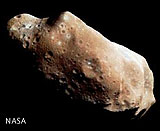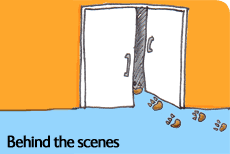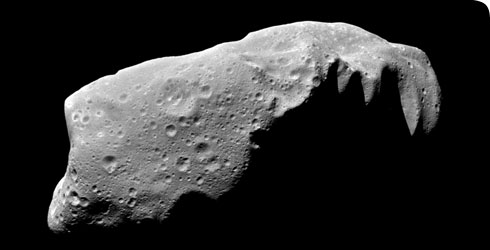Asteroids
Asteroids are rocky objects. There are many different types of asteroid, consisting of different amounts of metal, silicate and carbon. They also have different histories. Some of them have completely melted like the planets, whereas others have not melted but have been altered by water. This means there are a wide variety of structures both inside and on the surface of asteroids, formed by their turbulent existence.

The asteroid Ida is about 55km long. It is one of thousands of asteroids in the asteroid belt. © NASA
Piles of rubble
Rather than one solid mass, asteroids are groups of several rocks, or rubble piles, held together by their own gravity. The largest and oldest asteroids are nearly spherical and are made up lots of smaller rocks. These are known as mature rubble piles. The largest asteroid, Ceres, is 933 kilometres in diameter, about the length of England. Asteroids this big are called minor planets. Newer asteroids may only contain a couple of large rocks and are known as contact binaries. These asteroids are about 10 metres across.
The asteroid belt
Most asteroids are found in a belt orbiting the sun between Mars and Jupiter, 300,000,000 kilometres away. There are maybe millions of asteroids in the main belt. They are thought to be debris from a planet that failed to form when the solar system was created. These asteroids have, however, changed a lot from when they were first created due to billions of years of collisions. During these collisions, fragments can break away. It is these fragments that make up most of the meteorites that fall to Earth.
Near-earth asteroids
Some asteroids get pushed out of the main asteroid belt by the massive planet Jupiter. As they pass Jupiter, its gravity tugs on the asteroid, causing their orbit to wobble. This happens each time the asteroid travels around the sun until eventually the wobble gets so big the orbit breaks and the asteroid shoots away. Sometimes these new paths cross the orbits of the terrestrial planets, including Earth. These asteroids, typically up to 10 kilometres in diameter, can come very close to Earth, so are known as near-earth asteroids. They have even been known to crash into Earth, generating craters hundreds of kilometres across.
Toolbox

Our scientists study the snails that host the schistosomiasis parasite, which causes a disease that affects nearly 200 million people.
